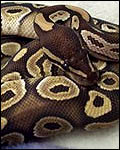» Site Navigation

0 members and 3,221 guests
No Members online
Most users ever online was 6,337, 01-24-2020 at 04:30 AM.
» Today's Birthdays

» Stats

Members: 75,095
Threads: 248,538
Posts: 2,568,726
Top Poster: JLC (31,651)
Welcome to our newest member, Daisyg
|
-
BPnet Veteran


randomn questions?
are bps territorial? and do they see in color? and if they do are they attracted to bright colors?
-
-
Registered User


Re: randomn questions?
I...honestly don't know. I don't think they are territorial and I know my Balls seem more interested in warmth than sight when it comes to prey so I'd have to consider them to have not awesome sight.
1.1 Mojave BP ("Caffè Macchiato;" name pending)
1.0 Cinnamon BP ("Jayne")
1.0 Pastel BP ("Elliot")
0.1 Normal BP ("Biscotti")
0.1 Spider BP (name pending)
0.1 Apricot Pueblan Milksnake ("Bowline")
1.0 Dumeril Boa ("Julien")
0.1 Super-Dwarf Reticulated Python ("Temperance")
-
-
Registered User


Re: randomn questions?
©1999 Melissa Kaplan
Snakes have rods and cones in their eyes, as do we, though in different numbers. They do not have the diversity colored oil droplets (presumed to have been lost when snakes when nocturnal and subterranean) in their photoreceptors that mammals and birds do, so, while they do have color vision, it isn't as broad ranged as ours is. They do have a yellow filter which, filling the lens, absorbs ultraviolet light, protecting the eye.
Snakes use a combination of infrared vision (developed in the trigeminal nerve), variable (by species) visual acuity and color detection, limited eye mobility, and chemosensation to find prey and recognize features in their environment (including their keepers).
Lizard (including geckos) and turtle retinas contain multicolored oil droplets in their photoreceptors, so they can perceive color. The opsin proteins in the cones in the eye are "calibrated" to detect different wavelengths. In many species, this enables them to see into the higher wavelengths beyond the scope of unaided human vision: into the UV range.
Nocturnal reptiles usually have smaller eyes than diurnal ones, but relatively large pupillary and lens aperture and cornea. This improves their light-gathering ability, but at the same time reduces visual acuity.
Lizards can focus on near and far by squeezing or stretching their lenses, using the ciliary muscles and annular pads. Pupils dilate and contract in response to light. Nocturnal geckos like the tokay have a stenopaic pupil: contracts into a vertical slit composed of a linear array of dots. Some nocturnal lizards have slit pupils, others are round. Lizards, unlike other reptiles, have a choroid body, called the conus papillaris. Projecting out into the vitrious humor, it nourishes the cornea.
-
The Following User Says Thank You to chaddeus71 For This Useful Post:
 Posting Permissions
Posting Permissions
- You may not post new threads
- You may not post replies
- You may not post attachments
- You may not edit your posts
-
Forum Rules
|